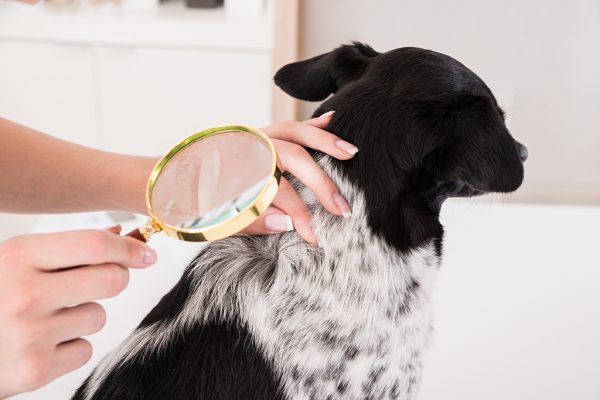Fleas and ticks are the most common external parasites that invade our dogs and cats. Naturally, we get worried about their presence since they seriously affect animals’ health; cause injuries, infections, anemias and even transmit diseases which can also affect our family: even though this can be unusual, fleas and ticks may bite humans as well.
Ticks are arachnids that belong to the same family as spiders. They neither fly nor jump, but they take the opportunity to make contact with dogs and, more eventually, with cats and humans. They are fed on blood, and during their life cycle, they mature in 4 stages: the egg from which the larva emerges to become a pupa and, finally, turn into an adult flea. They climb on the animal to feed, and drop to the ground to mature into the next stage.
What is surprising about ticks is that every female lays more than 3,000 eggs on the ground. When going down and up from the animal to the ground and vice versa they increase the probabilities of disease transmission, since they can bite the same or a different animal. Also, they are long-standing and may remain “latent”, waiting for ideal environmental conditions to come into action. They are easy to detect for their size, mainly on ears and underarms; and since they firmly attach to the skin to feed, it is not recommended to tear them off, because the animal may be hurt even more.
On the other hand, fleas are very small and agile —turning them into elusive parasites— and they may jump long distances, making them difficult to detect at a glance. The most common symptom is the intense scratching, more or less vigorous, depending on the animal. To feed, fleas spread their saliva, preventing blood from coagulating; and this causes allergy in most pets, exacerbating the itching and the stress on such animals affected.
You will find below key information on these two parasites:
Ticks
• A female tick lays thousands of eggs per day.
• There are four stages in the life cycle of a tick: egg, larva, pupa and adult.
• Every change of stage is made in the environment, climbing on the animal to bite it and feed.
• They are disease carriers, since they do not remain all the time in one same animal, and when beating, may spread the disease.
• They have a feeding system that attaches deeply to the skin; therefore, when you see a tick, you should not tear it off.
Fleas
• Fleas have legs that allow jumping long distances, up to 200 times the length of their own body.
• Each flea may lay between 40 to 50 eggs per day, and more than 600 eggs during their life cycle. We can easily turn from having just one flea to thousands of fleas at home.
• Adult fleas live all their life cycle beating pets, but eggs, larvas and pupas live in the environment and they represent the “real” problem for their eradication.
• Pupas remain latent inside a very resistant cocoon, waiting proper conditions to go out. Until signs like temperature, humidity, vibrations and gases that we eliminate when breathing, “wake them up”, and they start beating.
• The flea’s saliva has an anticoagulant that allows feeding all the time.
• Some animals develop allergies to flea’s bite, and suffer from dermatitis, producing itching and stress.
• Like ticks, fleas are disease carriers; therefore, it is important to eliminate them, and specially, prevent them from beating your pet.
It should not be forgotten that these parasites may spread all over the house, and reproduce themselves in warm places like carpets, blankets and pillows. So, if you notice that your pet is being affected by any of these parasites, it is recommended to choose products acting on the animal and the environment to protect your home.
The solution to this problem offered by Labyes is Protech. The new Protech’s formula eliminates fleas, ticks and mosquitoes from your pet, and acts against the immature forms laying on the ground, carpets and beds. In this manner, it is possible to put an end to the reproductive cycle of these parasites, and offer a definite protection to your pet and family.
If your pet is a dog, you may use Protech Spray to reinforce the repellent action, applying it on underarms, behind ears, on groin, hands and feet; before and after walking your dog, or going to the park, square or the beach. To intensify the environmental action, you may also apply it in most commonly used areas of the house: bed, carpet, or your favorite pet’s couch.
If you have any doubt, you must always ask a reliable Vet, who will provide you the best indications of a sanitary plan for your pet.

